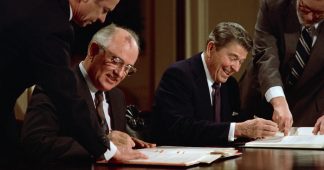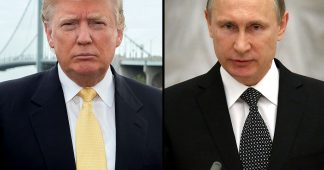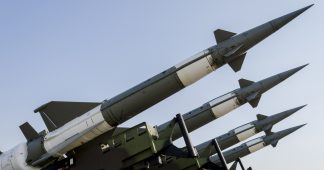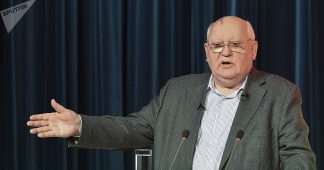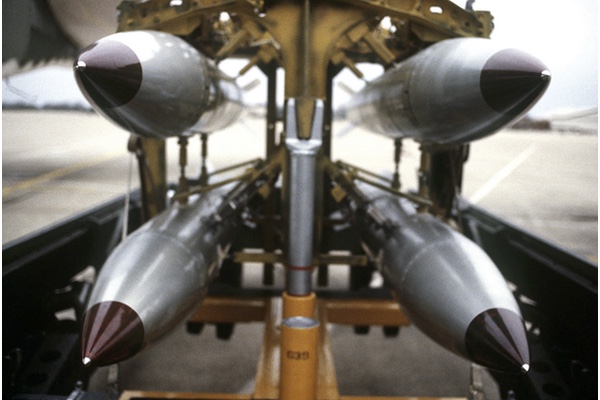By Adam M. Scheinman
14 March 2018
North Korea’s nuclear build-up continues. Vladimir Putin announced on March 1 that Russia had developed new nuclear weapons—an announcement timed, no doubt, to one-up the US Nuclear Posture Review, which was released in February. Amid developments such as these, some observers worry that nuclear weapons are back, big time.
The truth is that they never really left. Yes, total stockpile numbers have come way down from their Cold War high. But the strategic rationale for retaining nuclear weapons remains. That’s unlikely to change any time soon—so what can realistically be done to stop nuclear wars before they start?
Some disarmament advocates, reflecting a human tendency to seek simple solutions to highly complex problems, favor a moonshot approach—they want, as a first step toward abolition, to prohibit nuclear weapons by treaty. For the United States, a nation with significant military responsibilities, the equation works in reverse: Nuclear weapons will be needed for deterrence as long as Washington’s military competitors possess them. It is an uncomfortable fact of life in the United States that nuclear weapons are both protagonist and antagonist. They are both a safeguard for US security and a massive threat to it. Resolving this tension has been the métier of policy makers and scholars for the entirety of the nuclear age, and the tension is sure to persist until the major powers all but eliminate their differences—and until the regional competitions that give rise to nuclear proliferation are resolved.
No such resolution appears imminent. Reductions in the US and Russian arsenals, beyond those stipulated under New START, seem a distant prospect. Russia waved off President Obama’s offer in June 2013 to negotiate a new round of nuclear cuts and then proceeded to persist in violating the Intermediate-Range Nuclear Forces Treaty. As for multilateral pacts that would bring a broader set of players into the disarmament process, this prospect seems distant as well—and the reality in any event is that China, France, and the United Kingdom maintain much smaller nuclear arsenals than do the big two.
What then? Well, a 1973 agreement between the United States and the Soviet Union—little noticed when signed and largely forgotten since—holds some promise in the current environment. The US-Soviet Agreement on the Prevention of Nuclear War, signed during a period of US-Soviet détente—and, admittedly, more symbolic than substantial—called on the two states “to remove the danger of nuclear war and of the use of nuclear weapons” and “to prevent the development of situations capable of causing a dangerous exacerbation of their relations,” which might lead to a nuclear war.
Arms control advocates understandably focus their efforts on reducing numbers of warheads and missiles. But until nuclear reductions are back on the table, revisiting or updating the 1973 agreement could provide an alternative framework for discussions across a broad range of strategic nuclear issues and concerns.
Wise goal, great hopes. In the 1960s, US policy makers began to seek a wise goal: ensuring that fewer fingers gripped the nuclear trigger. They worked to prevent the spread of nuclear weapons. They lowered risks by pursuing arms control agreements with the Soviet Union.
For Defense Secretary Robert McNamara and other Americans who participated in the 1962 Cuban Missile Crisis, the principal lesson learned was that American cities, because of the potential fog of miscalculation, misjudgment, or miscommunication, faced an intolerable risk of absorbing a nuclear strike during a crisis. The nuclear war scare over Cuba generated new imperatives for policy makers. Crises must be avoided. Strategic stability—a situation in which neither the United States nor the Soviet Union would have reason to fear a nuclear first strike—must be established. Rough nuclear parity must set the bar for nuclear use as high as possible.
Starting with the Glassboro Summit—a 1967 meeting in New Jersey between President Lyndon Johnson and Soviet Premier Alexei Kosygin—McNamara sought to persuade the Soviets that placing limits on nuclear missiles and ballistic missile defenses would provide the best protection against an unconstrained arms race and a nuclear war that neither side sought nor wanted. Five years later, Richard Nixon—carrying forward policies begun under the Johnson administration—signed a series of agreements with Soviet leader Leonid Brezhnev, principally SALT I and its first cousin, the Anti-Ballistic Missile Treaty.
The Soviet collapse in 1991 generated great hopes that huge new leaps in disarmament were possible. Indeed, the landscape of the last two decades is dense with nuclear achievements, from efforts at cooperative threat reduction, which eliminated many retired strategic nukes in Russia, to New START, a treaty that brought the US and Russian nuclear arsenals down to historic lows. Unfortunately, the tide has turned again under Putin. He is doubling down on nuclear weapons, presumably to underwrite revanchist policies in the former Soviet space and to offset Russia’s conventional military inferiority vis-à-vis the United States and NATO.
Nuclear challenges, of course, are not limited to the European continent. China continues its slow, unconstrained march toward a robust nuclear deterrent, presumably to secure its freedom of action in the Asia-Pacific—and perhaps, by the end of the century, worldwide. North Korea’s nuclear build-up represents another enormously consequential danger, as do uncertainties about Iran’s nuclear ambitions and the real risk that India and Pakistan will stumble into a nuclear war. Against this backdrop, the treaty to ban nuclear weapons (passed at the United Nations last year) seems impractical—or, at the least, unlikely to achieve its goals soon. Still, in the interim, security in a nuclear-armed world must be maintained, and hopefully improved.
The United States and Russia could take a modest but significant step in that direction if they re-engaged over the 1973 US-Soviet Agreement on the Prevention of Nuclear War.
How would it work? For starters, the two sides could simply reaffirm the agreement, which remains in effect. At a time when both sides are modernizing their nuclear arsenals, and when nuclear rhetoric has grown distressingly heated, an affirmation that Washington and Moscow wish to “remove the danger of nuclear war and of the use of nuclear weapons” would be welcome.
As a further step, the two sides could use the agreement as the basis for a new political understanding—a multilateral understanding that also included China, France, and the United Kingdom (the nations that, along with Russia and the United States, constitute the five nuclear powers acknowledged under the Nuclear Non-Proliferation Treaty [NPT]). These five countries already have a long tradition of issuing joint statements at meetings concerning the treaty. More recently, they have held a series of annual conferences to promote greater transparency and dialogue regarding NPT commitments. The NPT-5 could now come together to negotiate a political statement containing three elements: policy commitments, confidence-building measures, and structures for enhanced dialogue.
The 1973 US-Soviet agreement contained commitments that guarded against the use of nuclear weapons. Some of these, still relevant today, could serve as a basis for parallel commitments by the five nations. Likewise, the NPT-5 could affirm the principle in the UN Charter that upholds states’ territorial integrity and political independence, with this principle understood to mean that forcible alteration of national borders is not to be tolerated. The five countries could also make commitments that build on their past joint statements—for example, at the 2015 NPT Review Conference (which I led for the United States), the five affirmed that the Cold War nuclear arms race was over and should not be resumed. They further agreed that, in recognition of the horrific consequences of nuclear weapons use, they would continue prioritizing actions to prevent an accidental or unauthorized launch. Both concepts bear re-emphasis.
The five countries could also agree to undertake a set of confidence-building and security-building steps. These could include exchanges (at the unclassified level) on practices to ensure the safety, security, and effective control of nuclear weapons. Such exchanges could evolve into a set of best practices for possessors of nuclear weapons.
Finally, the five nuclear weapon states could commit to deepened dialogue on nuclear issues around which they have significant expertise—in particular, nuclear terrorism, treaty verification, and the role they would play should a nuclear weapon go off somewhere in the world. The NPT-5 could also commit to conducting exchanges on parameters for strategic stability and possible steps to reduce tensions—such as briefings on military exercises. The five should agree that exercises must not include options for nuclear strikes or in any other way weaken the firebreak between conventional and nuclear warfare. They could also commit both to preserving and fully upholding existing arms control agreements, and even to studying the political, technical, and institutional conditions necessary for achieving the ultimate ambition of a world without nuclear weapons.
The advantages to updating the 1973 US-Soviet agreement, and treating it as a common political understanding, are numerous. Such an approach would allow the nuclear powers to take a breath—that is, they would gain space for dialogue on reducing nuclear risks. The process would not impose new legal obligations on any state, making negotiations both more manageable and more attractive to Russia and China. The process would also be welcomed by US treaty allies in Europe and Asia, who fear that military confrontations between nuclear powers could expose them to the threat of nuclear attack.
The new US Nuclear Posture Review states that future arms control efforts should be judged by their ability to improve US security. That, of course, is the correct measure. But Russia’s behavior inspires little optimism regarding new arms control agreements. Moscow has violated the Intermediate-Range Nuclear Forces Treaty. It engages in chest-thumping nuclear rhetoric and exhibits a wider dissatisfaction with its place in Europe’s security architecture. Nor can new arms control ideas be expected to spring from Beijing.
An updated Agreement on the Prevention of Nuclear War would hardly be a panacea for nuclear threats, or a substitute for arms control. It would not, nor should it, replace bilateral strategic dialogues between the United States and Russia or China. Those efforts, which address national perspectives on specific political-military concerns, should continue. But amid today’s challenging political environment, updating the Agreement on the Prevention of Nuclear War—though a small step—could nonetheless thin out that fog of miscalculation that McNamara identified many decades ago and help reduce nuclear risks until more effective approaches are possible.
